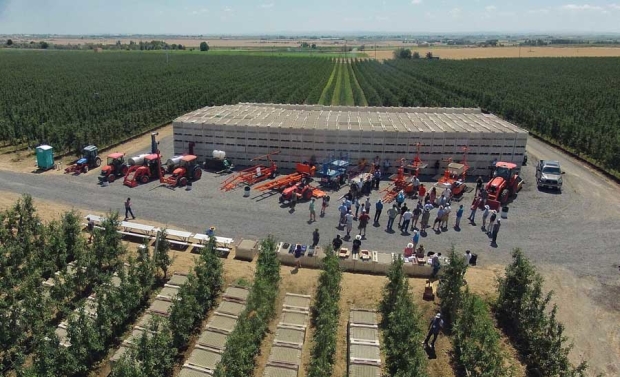
Harvesting, pruning, trimming and bin removal machines like these displayed during an IFTA tour last summer in Washington can help growers reduce labor, improve orchard production and decrease costs. (TJ Mullinax/Good Fruit Grower)
The cost of producing apples has been rising faster than expected, largely because of increasing labor costs, but costs can be offset by higher yields, Tom Auvil, research horticulturist with the Washington Tree Fruit Research Commission, told growers at the Washington State Tree Fruit Association’s Annual Meeting in December. The higher the yield, the lower the production cost per unit.
“Today, we have a number of companies that have successfully accomplished annual production of 100 bins per acre on Gala, so they’re managing their costs very well,” he said. “This is one of the most exciting times in the industry. There are a lot of different production systems that give high yields and a high-value product.”
Besides being more productive, modern systems can accommodate labor-saving technology such as platforms and mechanical-assist equipment.
There’s the potential for robotic harvesting in the next few years, but it will not work in orchards where the trees have long, whippy limbs, Auvil warned. “It requires a whole different paradigm on how we prune and train the canopy to maximize the value of the robotic harvester.”
Adopting new technology does not necessarily mean ripping out the whole orchard, Auvil stressed. Grafting can be a viable solution for switching to a different variety or a new production system very quickly.
However, growers are easily deterred from adopting new technology if they’re uncertain about how successful it will be. Even little quirks or small problems can create difficulties with acceptance.
“I have found that one coffee-shop failure discussion needs about 10 success stories to overcome a minor challenge,” he said.
For growers concerned about the cost of implementing new technology, Auvil said that new ideas can be introduced gradually. For example, in his own orchard he took five years to switch from wooden to aluminum ladders back in the 1970s.
“When we look at harvest tools, we never bought them all in one year,” he said. So when we start looking at really expensive tools in the future, we don’t have to equip the whole farm all at once. As a matter of fact, the more expensive some of this stuff gets, we need to make sure we know how to make it work really well before we buy or rent the second one.
Orchard renewal
Clark Seavert, agricultural economist with Oregon State University, said that when growers plant or renew an orchard, they tend to focus too much on the cost and not enough on having the varieties and training systems that will generate the fruit prices and yields they will need to be successful.
The three key factors in successful orchard renewal are (in order of importance): fruit price; yield (how much and when); and costs of establishment and production.
Thirty years ago, a yield of 40 to 50 acres was considered good, Seavert said. Even five years ago, yields of 75 bins were impressive. Now, yields of 80 to 100 bins per acre are not uncommon.
However, costs have also risen, with establishment costs as high as $45,000 per acre, and margins are getting slimmer.
There are two different business strategies growers can adopt. One is playing to win, with the focus on rewards, and the other is playing not to lose, with the focus on measuring risk. A grower might fall into both camps at different times, depending on what they’re trying to accomplish, Seavert said.
Playing to win involves profit maximization and adoption of new technologies. Those playing not to lose will take a wait-and-see approach, which is not necessarily a bad thing, he stressed.
If there’s money to be made, both of these groups will make money, but those playing to win will make more.
Seavert recommended that growers develop a five-year business plan. Nowadays, a 10-year plan is too long range because of how quickly things change.
The plan should include specific goals, so progress can be monitored. For example, a goal might be to increase gross revenue to $25,000 per acre, or to increase net farm income by 5 percent annually, or to improve labor efficiency by adopting new technologies.
Although growers have made enough money in recent years to finance new projects and purchases without bank loans, Seavert said they should use financing appropriately and not short their working capital.
He recommended planting varieties that fill gaps in the harvest window in order to use labor and machinery efficiently, and said growers should be preparing to accommodate fully automated harvesting. •
– by Geraldine Warner
ONLINE
Clark Seavert, agricultural economist with Oregon State University, and his colleagues are developing a suite of economic, financial and environmental decision-making tools for growers, which can be found at www.agbizlogic.com






Leave A Comment